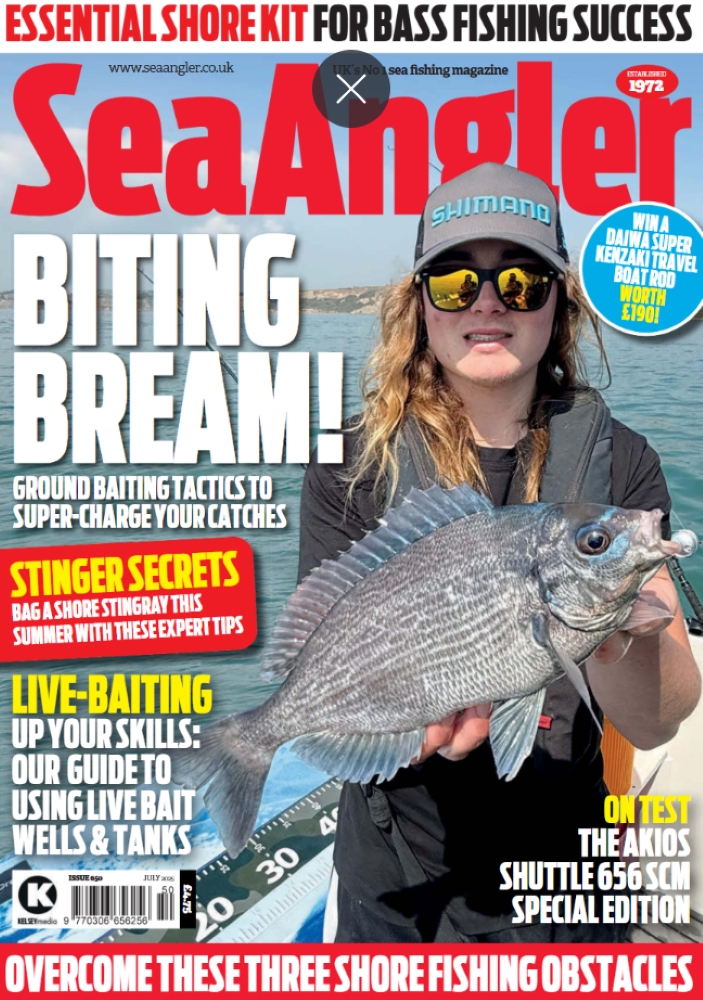Fishing below the sandstone cliffs of the North Heads gives access to deep water, providing the opportunity to catch better-quality fish.
The fishing is from sandstone ledges and huge rocks into rough ground and kelp. Long casts generally put your bait on to sand. Fish can be caught at most stages of the tide. Care must be taken, because you can get cutt off in some areas from half tide up.
Expect to catch cod, pollack, bass, congers, dogfish, whiting, wrasse, plaice and dabs.
Lugworms and ragworms work well through most of the year for various species, but bait-robbing crabs can be a nuisance. Tipping worm baits with mackerel or squid takes whiting and dabs.
Crabs are best in summer for cod, bass and pollack. Spin a jellyworm or sandeel in calm conditions for pollack and bass. A large mackerel bait fished close in tempts conger eels.
You need a strong beachcasting rod and a reel loaded with 30-35lb line. A pulley-rig armed with size 2/0 – 6/0 hooks and a 5 – 6oz grip lead should be attached to a rotten-bottom system when fishing the rougher ground.
Use a two-hook rig with size 1 – 2/0 hooks and reel line of 20 – 25lb on the cleaner ground. A light beach rod and reel with 20lb is best for spinning a jellyworm and a 2 – 3oz sinker.
After you arrive at Sandwith at the end of the road turn left, then right. Half a mile further on you take a left and it’s half a mile before turning right into Sandwith. 100 yards past the pub turn right at the phone-box on to a single track private road leading to the lighthouse.
After a mile you come to a farm; the farmer does not allow vehicles to proceed past the farm but provides car parking at £1. Payment is via an honesty box. Occasionally the car park is closed for safety reasons.
Walk through the gate towards the lighthouse and take the first gate on the left, keeping to the edge of the field down to Fleswick bay. Walk along the bottom of the cliffs. You can also get to the heads by walking up to the lighthouse where there are several tracks and chains down the cliffs, but these are best used in the company of someone who knows the area.
SPECIES
Cod, pollack, bass, conger eels, dogfish, mackerel, whiting, wrasse, plaice, dabs and rockling.
BAIT AND TACKLE
Lugworms and ragworms work well through most of the year for various species, but bait-robbing crabs can be a nuisance. Tipping worm baits with mackerel or squid takes whiting and dabs.
Crabs are best in summer for cod, bass and pollack. Spinning a jellyworm or sandeel in calm conditions for pollack and bass. A large mackerel bait fished close in tempts conger eels.
Use a strong beachcasting rod, a reel loaded with 30-35lb line, a pulley rig armed with size 2/0-6/0 hooks and 5-6oz grip lead attached to a rotten-bottom system when bottom fishing the rougher ground close in.
Use a two-hook rig with size 1-2/0 hooks and reel line of 20-25lb when fishing the cleaner ground. Use a light beach rod and a reel with 20lb line when spinning a jellyworm and 2-3oz lead weight.
TACKLE SHOPS
Cumbria Angling Centre, 5 Tangier Buildings, George St, Whitehaven, tel: 01946 693233.
Opening times: Tuesday to Friday 10am-6pm, Saturday 9am-5pm, Sunday 10am-2pm.
Bait: Fresh and frozen.
Graham’s Gun and Tackle Ltd, 9-15 South William St, Workington, tel: 01900 605093.
Opening times: 9am-5.30pm Monday to Saturday.
Bait: Live rag and frozen bait.
Number of lakes/pegs : N/A
Prices : £1 to park at farm
Directions : Take the A595 south past Whitehaven. At the end of the Hensingham bypass follow the Barrow road, then take the second turning on the right to Sandwith. At the end of the road turn left, then almost immediately right. Half a mile further you take a left turn and it’s a further half mile before turning right into Sandwith.
Season : All Year







